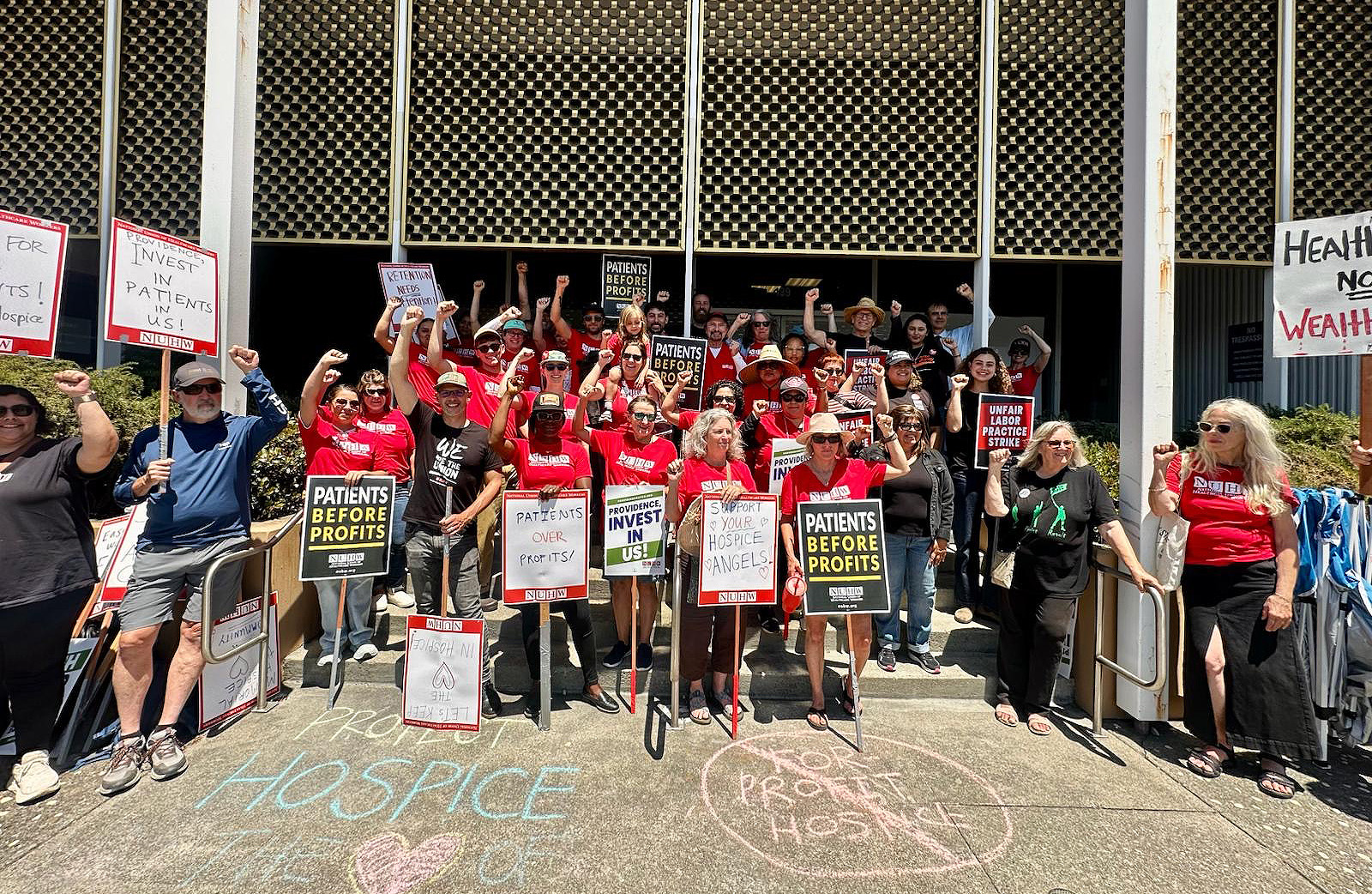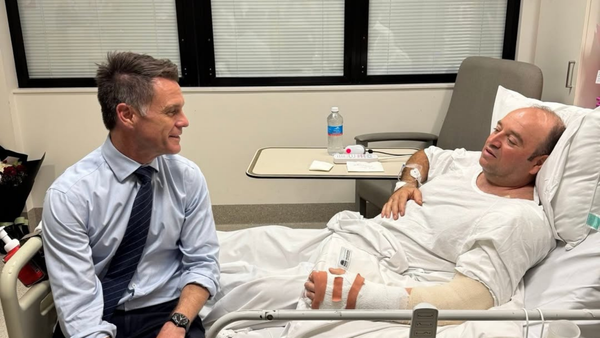
When hospice nurse Kristina Nauheimer joined the growing unionization push among end-of-life care workers in 2022, she knew there was a fight ahead. But she and her coworkers at two Bay Area hospices in California didn’t expect to be at the negotiating table with Providence, their hospice operator, for more than two years — or that their employer would merge with a private-equity-owned firm.
“I didn’t think it would take this long to achieve this little,” said Nauheimer, who joined about 100 workers from the company’s Hospice of Petaluma and Santa Rosa Memorial Hospice in a two-day strike with their union, the National Union of Healthcare Workers, on July 2 and 3. They struck, said Nauheimer, because contract negotiations with Providence, their operator, have been at a standstill.
What’s more, union members say they’re worried that the delay signals a planned merger between Providence and a private-equity-owned care provider, Compassus, will erode working conditions and care instead of improving them.
The solution, as hospice workers see it, is simple: Sign a contract that addresses the concerns that led them to vote for a union in February 2023 — 29 months ago. The union, which includes social workers, chaplains and hospice aides and nurses, said it’s bargaining for case limits for case managers, fair pay and reasonable limits on their workloads — which in turn will protect the quality of care for patients.
Compassus declined to answer specific questions for this article. A spokesperson provided a statement saying the company has a commitment to “advance well-being and honor quality of life,” and provide “high quality care,” concluding, “our mission is shared by our partners.”
Providence did not return multiple requests for comment.
On a typical day, Sabrina Hearst, a hospice team nurse, drives to patients’ homes. There, she might respond to a crisis call when a patient is in severe pain or is short of breath, or conduct a follow-up visit to a patient newly admitted to the hospice. She might dress a wound or tend to a bowel disimpaction. Whatever she’s doing, providing good care means she needs to establish a rapport with patients and their families and not rush through a visit, she said. Some visits last 40 minutes; others take several hours.
“We’re trying to preserve the ability to be present [and] honor end-of-life care, and which you do by not allowing [management] to overburden the staff with impossible caseloads, right?” Hearst said.
While the average time from unionization to contract for health care workers is 18 months, Hearst and her colleagues are facing an unusually lengthy delay. In 36 bargaining sessions, union members said they and management have made virtually no progress. On June 4, the union filed an unfair labor practice charge with the National Labor Relations Board, alleging that Providence engaged in “sham bargaining” and refused to bargain in good faith.
“Providence [the owner-operator] continues to [make] proposals no one in their right mind would agree to,” Nauheimer said. One proposal, she said, did not include any new raises but included a possibility of pay cuts.
Workers said they are also concerned because of Providence’s 2024 agreement to merge with Compassus, which is part of the portfolio of a private equity firm, TowerBrook Capital Partners (TowerBrook owns Compassus equally with health system Ascension). The deal yielded $152 million for Providence and gave Providence and Compassus equal ownership of 17 hospices and palliative care facilities and 24 home health locations.
Ascension and TowerBrook did not return requests for comment.
While most hospices have become for-profit businesses in the last decade, private equity investment in end-of-life care has boomed over the same period, sometimes with disastrous results. From 2011 to 2019, private equity ownership of hospices tripled, according to a 2021 study published in the journal JAMA Internal Medicine.
Meanwhile, private equity is rapidly becoming commonplace across health care, from hospitals to home care. Research suggests that quality of care and patients’ experiences worsen at hospitals after they are acquired by private equity firms. When workers try to form unions, private-equity-owned firms are disproportionately likely to block those efforts; last year, the Private Equity Stakeholder Project, a nonprofit watchdog organization, reported that private-equity-owned companies accounted for 15% of all labor consultant contracts but accounted for only 9.4% of private-sector workers.
Hospices are particularly vulnerable to private equity takeover because the industry’s payment structure incentivizes “financialization,” said Eileen Appelbaum, co-director of the Center for Economic and Policy Research and co-author of a recent report on private equity’s involvement in hospice care.
Medicare covers the majority of hospice patients; its beneficiaries accounted for more than 90% of all hospice patient days in 2021, and Medicare pays between $176 and $224 for at-home care per day per patient, regardless of whether the patient receives care on any given day. “The [payment structure] was to provide income, in advance, so that hospices [can] use that money to take good care of the patients. But you don’t have to do that, do you? Because you get to keep whatever you don’t spend on the patient. That becomes an attraction for for-profit providers and for private equity,” Appelbaum said. Under that model, union members worry that the only way to boost profits is to have each staff person care for a large number of patients.
Private equity ownership only intensifies the pressure to boost profit, said Eileen O’Grady, the director of programs of the Private Equity Stakeholder Project. Most private equity firms seek to double or triple an investment in four to seven years, she said.
Already, hospice workers said they have noticed cost-cutting measures that could degrade patient care, including an increased emphasis on maximizing the number of visits per shift and replacing liquid medication, which is easy for the sick to ingest, with tablets that are harder to swallow — but cheaper. Hospice workers were not comforted by a comment thread in an online hospice support group, Nauheimer said. There, multiple nurses complained about Compassus’ focus on profit over care; one nurse said Compassus’ hefty caseloads made it “physically impossible for the patient’s needs to be met.”
Hearst and Nauheimer said that their hospice isn’t perfect, but that — as it runs now — they and their colleagues are proud of the level of care that they provide. Their hospice has the top ranking in Sonoma County.
“In health care, the way that you get returns is you cut costs, right? And that burden will fall on staff,” Nauheimer said. “This kind of arrangement almost makes me feel like I couldn’t be that kind of nurse.”







